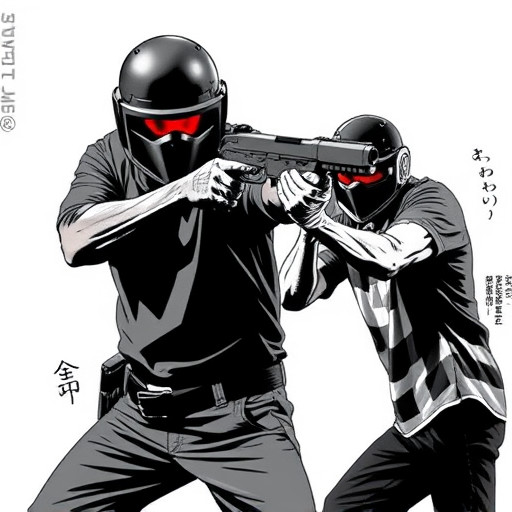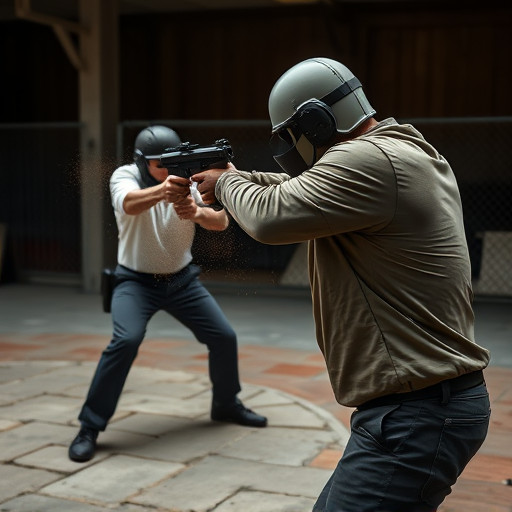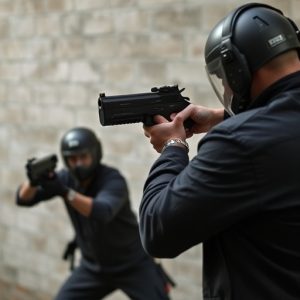Taser vs Stun Gun: Discreet Self-Defense Options Compared
Silent stun guns offer a discreet, non-lethal self-defense option with a single pulse delivery syste…….
Silent stun guns offer a discreet, non-lethal self-defense option with a single pulse delivery system and compact design, ideal for scenarios requiring surprise or secrecy. They are suitable for walks home at night or dealing with unexpected intruders, allowing users to quickly deploy them without alerting attackers or bystanders. Tasers, with their potent electric shocks, are better suited for close-quarters combat while stun guns provide extended reach for open spaces or larger targets. Both types face strict regulations globally, with legalities dictating possession and use; understanding local laws is crucial before acquisition. Choosing between them requires consideration of power, range, ease of use, and thorough training for high-stress deployment.
In the quest for personal safety, Tasers and stun guns stand out as powerful tools. Understanding their distinct differences is crucial for informed self-defense decisions. This article explores the intricacies of these devices, from the functioning of Tasers and their unique advantages to the discretion offered by silent stun guns—a preferred option for those seeking covert protection. We’ll also compare their power and range, delve into legal considerations, and guide you through choosing the ideal self-defense tool tailored to your needs.
- Understanding Tasers: How They Work and Their Unique Features
- Stun Guns: Discreet Deterrents for Personal Safety
- Comparing the Power and Range of Both Devices
- Legal Considerations: Usage and Regulations Across Different Regions
- Choosing the Right Self-Defense Tool: Key Factors to Consider
Understanding Tasers: How They Work and Their Unique Features

Tasers, also known as Electronic Control Devices (ECDs), are a type of weapon designed to incapacitate individuals using electrical impulses. They work by delivering a powerful electric shock through two probes connected to thin wires. This shock disrupts the nervous system, causing muscle spasms and temporary paralysis, allowing the user to gain control or escape from a dangerous situation. Tasers are known for their effectiveness in neutralizing resistance without causing significant harm, making them popular choices for law enforcement and personal defense.
One of the unique features of Tasers is their ability to provide discreet self-defense options with silent stun guns. Unlike traditional firearms, Tasers do not make loud noises during discharge, making them ideal for situations where a user wants to deter an attacker without drawing excessive attention. This feature aligns well with personal safety strategies, especially in scenarios where surprise or secrecy is crucial for avoiding escalation or unexpected consequences.
Stun Guns: Discreet Deterrents for Personal Safety

Stun guns, also known as electronic control devices (ECDs), are compact and non-lethal weapons designed to incapacitate an assailant through electrical pulses. Unlike tasers that use a pair of probes to deliver a high-voltage, low-current electric shock, stun guns emit a single pulse from a smaller tip or surface area, making them more versatile for close-range self-defense. Their discreet design and operation—typically silent—make them popular choices for personal safety, especially in situations where the user wants to avoid drawing attention.
These devices are often preferred by individuals who prioritize subtlety and discretion when carrying a self-defense tool. Silent stun guns allow users to deploy them quickly without alerting potential attackers or bystanders, providing an effective deterrent in various settings, from personal walks home at night to situations where an attacker gains unexpected access to a property.
Comparing the Power and Range of Both Devices

When comparing the power and range of Tasers and stun guns, it’s evident that both devices serve distinct purposes in self-defense scenarios. Tasers, also known as Electronic Control Devices (ECDs), are renowned for their exceptional stoppower, delivering a powerful electric shock that temporarily disables a target. They typically have a shorter range compared to stun guns, usually up to 15-20 feet, making them more suitable for close-quarters confrontations. This advantage ensures users can maintain a safe distance while neutralizing the threat.
In contrast, stun guns offer a different approach to self-defense with their ability to generate a strong electrical discharge over a slightly longer range, often extending up to 30 feet or more. The extended reach provides users with a tactical edge in open spaces or when facing larger targets. However, the power and intensity of the shock may vary between models, so choosing a stun gun with sufficient juice for discreet self-defense in tight spots is essential, especially for those prioritizing silent stun guns for personal safety.
Legal Considerations: Usage and Regulations Across Different Regions

In many regions, both Tasers and stun guns are subject to strict regulations due to their potential impact on public safety. Legal considerations play a significant role in determining who can possess, carry, and use these devices. For instance, some areas require specific permits or licenses for stun guns, while Tasers often fall under more stringent controls. In the United States, for example, Tasers are generally classified as less-lethal weapons and their use by civilians is regulated at the state level, with varying restrictions on age, training, and purpose.
Internationally, the legal landscape differs vastly. Some countries have banned stun guns entirely, while others permit them only under specific circumstances. European Union regulations, for instance, limit the voltage and energy output of stun devices, emphasizing a balance between self-defense and public safety. The availability and use of silent stun guns for discreet self-defense are thus influenced by these regional legal frameworks, underscoring the importance of understanding local laws before acquiring either device for personal protection.
Choosing the Right Self-Defense Tool: Key Factors to Consider

When considering self-defense options, understanding the differences between a taser and a stun gun is crucial. Both devices are designed to incapacitate an assailant but operate through distinct mechanisms. Tasers use electrical current to disrupt muscle control, causing the target to fall to the ground momentarily. On the other hand, stun guns emit a high-voltage, low-current electric shock that can temporarily paralyze an attacker for several minutes.
Choosing between them depends on specific needs and preferences. For discreet self-defense scenarios where silence is paramount, silent stun guns are often preferred. They offer a non-lethal way to deter attacks without drawing excessive attention. Factors like power, range, ease of use, and legal considerations should guide your selection. Additionally, training and familiarization with the device’s functionality are essential for effective deployment in high-stress situations.
When it comes to personal safety, both Tasers and stun guns offer effective solutions with distinct differences. Tasers, with their ability to temporarily incapacitate through muscle relaxation, are powerful but require direct contact. Stun guns, on the other hand, provide a non-lethal, discreet option for self-defense, making them ideal for those seeking silent deterrents. Understanding the legal landscape and individual needs is crucial when choosing between these tools. Whether it’s the reach of a stun gun or the unique features of a Taser, selecting the right device depends on specific circumstances, ensuring individuals can protect themselves with confidence.


